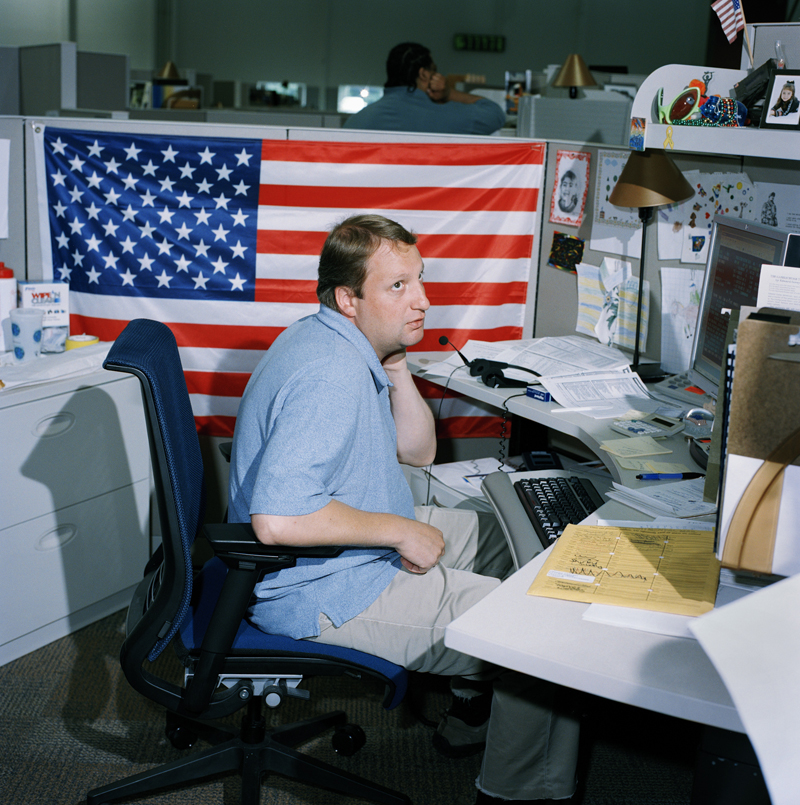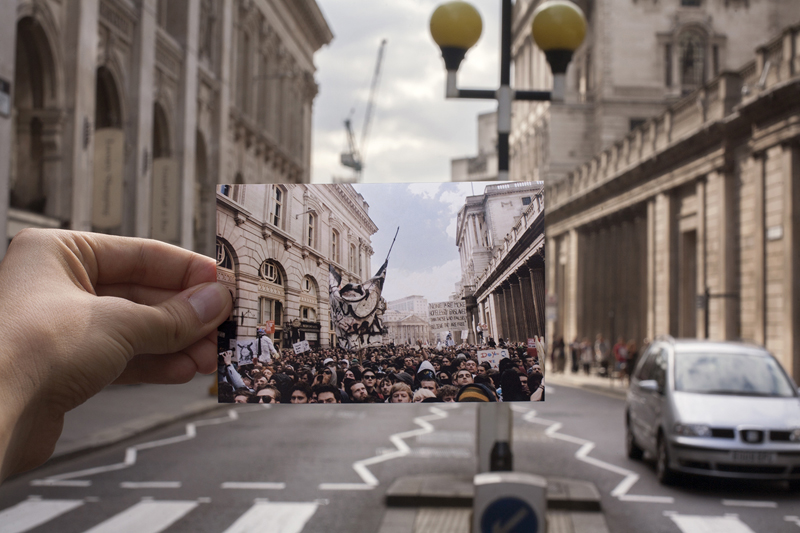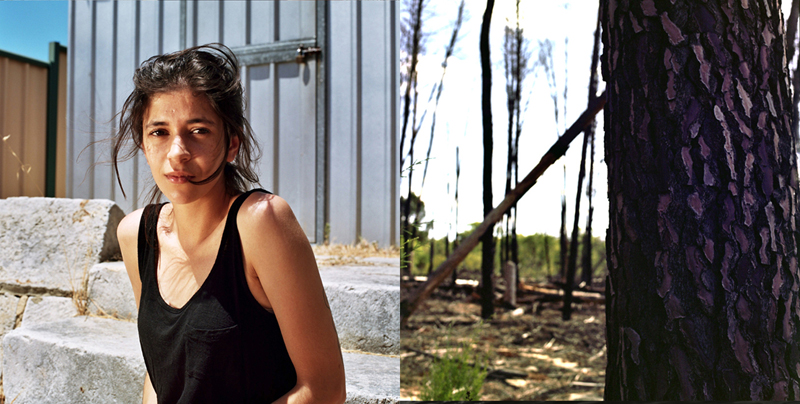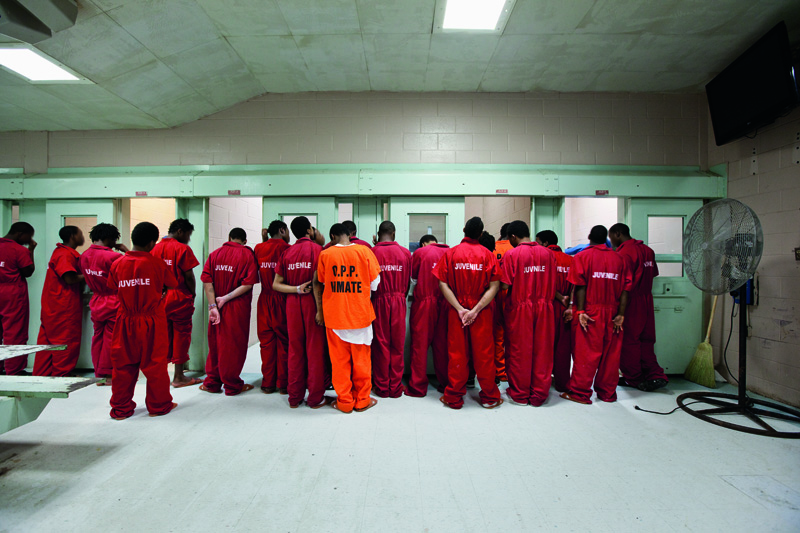
An interview with Open Eye Gallery's Exhibitions Coordinator Thomas Dukes on the open submissions process, by Anna Taylor
Open 1 was unveiled at Open Eye Gallery in May as part of LOOK/15, forming one of the programme highlights of Liverpool International Photography Festival. Curated around a theme of Social Portraiture, the collected works in this group show reveal something trans-cultural around the human condition and the social impact of consumerism and globalisation upon individuals and communities, manifesting here as boredom, protest, injustice, and wonder at the miraculous. The exhibition features work by Helen Marshall, Louis Quail, Deborah Kelly, Sonal Kantaria, Billy Macrae and Richard Ross.

Desk Job, Team Supervisor, Customer Service Representative, electricity and gas supplier, Berlin, Connecticut, USA 2007 © Louis Quail
Open 1 is formed from a selection of new photography projects submitted to Open Eye Gallery through its ongoing open submissions programme. This invites photography practitioners at any stage in their career to submit new work for consideration by the gallery’s curatorial panel. This culminates in a series of annual group exhibitions; Open 1, 2 and 3, funded for the next three years by the Brian Mercer Charitable Trust.
I catch up with Open 1 curator, Thomas Dukes to find out more about this opportunity for photographers, the curatorial thinking and process behind it, and for advice on making a strong submission to a gallery.
AT: As a gallery known for showing pioneering photography exhibitions in Liverpool since the 1970s, what prompted you to set up an open submissions process?
TD: We’d always had the submissions process because its always important to see what’s interesting to photographers out there, so for people to be able to send us their work, because its not always about the end point of putting photography on the walls, its handy to see what kind of themes photographers are trying to tackle, and how they want to look at things, and whether technology is important to them right now, or truth, or more abstract ideas, cause there’s always been the submissions thing there, but you always hear that question ‘I’m a practicing artist - how do I get my work on walls?’ and we realised there was loads of work that we were seeing, and some of it was pretty good, and if you get graduates putting in their final projects, you think ‘this could grow into something really exciting’, so it’s a perfect opportunity to see a brand new work and someone who has spent 3 or 4 years working on it to then make it the most perfect project…when else do you get that opportunity?
AT: Your submissions process is open to photographers at all stages of their career, but Open 1 is by artists who seem quite established…?
TD: There’s a bit of a mix, actually, I think at one point we didn’t know if it was going to be about emerging artists and purely championing that in this instance it is people whose work hasn’t massively been seen in the UK before. For example, Richard Ross’s work has been seen in The Guardian, its had editorial coverage and has toured in America, but not quite so much in the UK, so it doesn’t really fall into that bracket, whereas someone like Billy Macrae is fresh out of his masters and is looking to start work on his projects, so we’re looking at checking out a new person’s work. So I think it is a bit of a mix, and it is really good to champion fresh work, or work that hasn’t been seen.

G20 Double Takes, 2014 © Billy Macrae
AT: What are you looking for as a curatorial panel when you come to review submissions? Can you explain how your selection meeting goes?
TD: First we pick out certain things - what currently exists, how long you’d been working on a project, whether the project has any backers, whether it’s been seen before. Then we download all the images, then sit down, start opening up the websites and start looking at the work. I think the first two hurdles are competence of production and originality. So, if we look at it and think ‘I’m certain that someone out there is doing this and doing it better’, maybe we’ll hold on it. Or maybe people are working to a really high standard but the work is better suited to a different format. We actually saw loads of work that was for books – photographers making work for books. For example – Alexander Lethbridge - she’s actually just been in Fresh Faced and Wild Eyed. She sent us a book and I loved it, so I got back in touch and said ‘look this is really great work – you’ve got to send us more stuff’ – so [showing the book] there’s a run of 100 and there’s beautiful semi-translucent printing over previous work like this, colours…so its phenomenal, almost typologesque, with the landscape and so on, but it’s like ‘you’ve done it – you’ve nailed it, but maybe lets talk about a commission, maybe a year down the line and say well, what are you working on now, is it going to be more suited to the space. And then relevance is really important – that ties into originality in a way, but you say, ‘is this relevant work?’ We don’t always try to show socially engaged work, but work that connects us as human beings.
AT: Thinking around the theme of Open 1 - Social Portraiture. This comes together really coherently in this exhibition - did you arrive at a theme before selecting work, or did this come once you had a group of artists in mind?
TD: I think (as awkward as this sounds), half and half. It was always our intention to use Open 1 to address wider issues – to make photography as relevant as possible to as many groups as possible. To say that photography was uniquely placed to explore what brings us together, and what society is doing to a range of people and groups. But at the same time, when we were looking at work we did get a sense of social portraiture with the subjects and the sitters, and how they’re affected by wider ideas like mass consumerism, mass communication, mass norms, in some instances, and widely accepted behaviour. Sonal Kantaria’s work, for example, where it’s the freedom of the human and the lack of borders, asking ‘what’s our relationship to the landscape now? Are we tied to landscape? Are we free to change our home and is home part of portraiture?’ Moving onto Helen Marshall’s work, which is portraits of a dying art form – its all addressing wider globalisation issues.

Traces, Sigrid / Perth, 2013 © Sonal Kantaria
AT: Do you have ideas that you can talk about as to what you would like to explore in Open 2 and 3?
TD: The degree shows were really great this year, so we thought ‘yes, we’d really like to work with you’ and we had a couple of phenomenal submissions, so far more in the way. But this new batch of photographers are really considering how they want their work engaged with, so …I want my work shown in a cave, or a wooden plinth, so people are really thinking about what the site of consumption is going to be.
AT: And are you thinking about that too, for the model of Open? Different formats, maybe, or places for showing photography?
TD: I think I’m pretty much always thinking about that. Always. Because there’s a pretty good time and a place for showing work that’s about coming into a space and looking at what’s on a wall. But you can get this user fatigue, with a disinterested spectator thinking of a photography gallery as a vitrine, or pinned photographs to a wall, I really want to change that, so people don’t just think they’re going to come in, do a lap of each wall and walk out again. So for the next ones, we’re really going to look at the way people are playing with photography.
AT: You mention in the submissions guidelines that you may recommend people to international contacts – could you describe a bit about how curators share ideas or ‘ones to watch’, and how best to get on the radar?
TD: Do the submissions! And do portfolio reviews. The more you harass, and email and get in touch, eventually we’ll cave and say ‘ok you can show me your work’. And those times are super useful, because then you know that person and you know where their work is or what they’re doing. So you mention it to someone else. Tadgh Devlin, from Hugh Baird College sent me this morning - Carolyn Drake, who has just been accessioned into Magnum photographs. She did this really interesting project called Wild Pigeon. And I showed Sarah Fisher (Open Eye Gallery’s Executive Director) and she said ‘great you should send that to Ying at the Centre for Chinese Contemporary Art’ - because we’ve all got loads of work to do but we’re always interested in looking at pictures! So submissions and portfolio reviews. And do small exhibitions – I met Anna Lilleengen – she came and had a really nice portfolio review the other day, and she’s putting on shows in libraries and council establishments – and its great that she’s got the chance to work on a new project and showing her work, so these things are really useful.
AT: What are your key considerations when selecting and balancing a group of artists for Open?
TD: I like to think that there’s some kind of dialogue between the works as you come through the show, otherwise it’s a really disparate show and you wouldn’t get so much from that. Its like the sum of its parts; as you travel through, by the time you get to Richard Ross’s work, for example, you’ve got such an idea of where we’re coming from and feel like you’re really a spectator of global machinations, so by the time you get there you feel really angry, about corporations, and that’s perfect. So you start off with a really playful theatrical work and you move through - protest, workers, human travel, justice. It all works to bring out the best in each of them – together it needs that sense of synergy, or symbiosis.

Orleans Parish Prison, New Orleans, Louisiana 2009. From the series Juvenile in Justice © Richard Ross
AT: What happens with work that you like but does not fit into the group selection?
TD: We keep them in mind, hold them in the submissions folder, keep checking their websites to see what they’re up to and we potentially get in touch. We can say, ‘we’ve got this long term plan…maybe we can pencil something in later on, or get you involved with an event.’ If we like their work, but they are looking at something completely different from social portraiture, for example, then its keeping an eye on them, keeping in touch and building the relationship.
AT: Have there been any conversations or collaborations that have emerged between the artists and photographers since installing Open 1? Is this something that you might plan around with future editions?
TD: Yes – it didn’t happen so much in Open 1 – not brand new, anyway. But in Open 2, I want people to be able to react together. So that they can have some time thinking about each other, or have time and they can really add something and build something fresh. Because it would be really hard to try and orchestrate that alongside the normal programme, without having a dedicated residency or development programme, but it is the fun thing, isn’t it – them creating something new by us bringing them together.
AT: So the work submitted becomes a starting point, and then they are given a certain amount of money to develop some new work?
TD: Yes, and then you’ve always got that starting point – you’ve always got the basis for an exhibition if it all goes wrong! But ideally, that’s the best thing about us being here and doing the exhibition. So for example here, with Louis Quail we have developed a new set of prints that has built on what he submitted and hopefully he feels good about that, and he can move on, and his trying to develop gallery projects can be given a bit of a boost by being involved.
AT: What advice can you give to photographers considering making a submission to Open? How can people make a strong submission? What are the pitfalls to avoid when submitting work to a gallery?
TD: That’s huge! Projects. Projects are good – if you’ve got a project and can succinctly say what its about, that can really help. Then you’ve got an idea of what a photographer is aiming towards. But not an over complicated project with five massive concepts! But then that’s not to say that a photographer can’t just produce a wandering diary or piece that isn’t going to be phenomenal, so it’s always going to be the art. So that’s number one: take good photographs. And we’ll be aware if they look a lot like someone else’s - derivative work is difficult. This is made a lot easier if you share your work often and early – do that at some point, so people can say ‘oh yes that looks like that looks like such and such!’ And technical competence is important. But the project thing does help, a really good body of work. And prints, things do look better in print. So if you’ve got print share it – yes, share your work! And have a website and keep it up to date and do keep in touch - its much harder for us to keep in touch without one.
Open 1 continues to 23 August 2015
www.openeye.org.uk/main-exhibition/open-1
Opening times 10.30am-5.30pm, Tuesday-Sunday.
Closed on Mondays (except bank holidays) and during exhibition changeovers.
Please note: Open Eye Gallery’s Programme Team meet four times a year to review submissions. Please make sure that your submission meets one of the following deadlines: 31st January, 30th April, 31st July or 31st October.
Find out more about the open submissions process here.
Anna Taylor is a writer based in West Yorkshire. She is a director of LOOK: Liverpool International Photography Festival and is working with Touchstones Rochdale. Twitter: @annaceritaylor